|
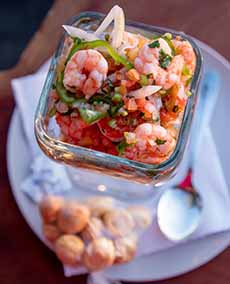
[1] Shrimp ceviche (photo © Yasmine Duchesne | Unsplash).

[2] You can serve ceviche in any type of dish, including rocks glasses and wine glasses (photo © Seviche Restaurant | Louisville).
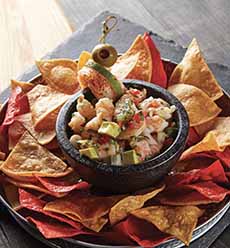
[3] Ceviche and tortilla chips are great with a glass of wine or a beer (photo © Chevys Fresh Mex | Flavor & The Menu).
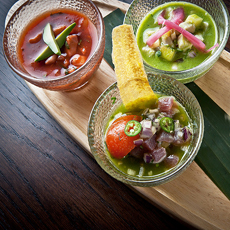
[4] Consider a tasting trio—triple the delight of ceviche (photo © Pampano Botaneria | NYC).
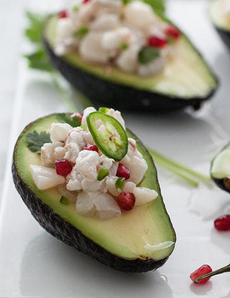
[5] Ceviche is a delicious stuffing for avocados (photo © Avocados From Mexico).
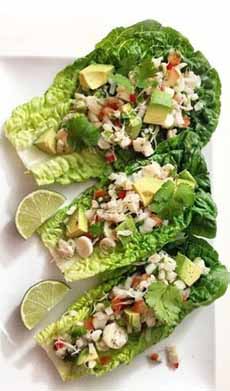
[6] Serve ceviche atop remain leaves for a first course or instead of a luncheon salad (photo © The Chalkboard).

[7] Ceviche with a fried plaintain garnish (photo © Chef Todd English | MXDC Cocina Mexican Restaurant | DC).
|
|
The third annual National Ceviche Day is June 28th, and we’ve got a bunch of ceviche recipes below. The holiday started in Peru, where ceviche is the national dish. Ceviche, seafood served chilled, is delicious any time of the year, but is especially refreshing in summer.
It’s a great dish: high in protein, low in calories, with as many recipe variations as there are cooks to create them.
Ceviche (pronounced say-VEE-chay) starts with raw fish and/or shellfish that is marinated and cured in citrus juice. The highly acidic citrus juice creates a chemical reaction in the proteins, the result of which is similar to what happens when the fish is cooked with heat.
As the fish marinates, you can see it change from translucent to opaque. For people who avoid raw fish: Consider ceviche to be cooked.
> The different types of raw fish dishes.
THE HISTORY OF CEVICHE
We don’t know how long ceviche has existed, only that it has been around for more than 500 years. In the early 1500s, the Spanish conquistadors wrote of an Inca dish of raw fish marinated in chicha, a fermented maize beer.
The Spanish contributed lime and onion, ingredients that are integral to modern ceviche. In fact, the term “ceviche” is thought to come from the Spanish escabeche, meaning marinade.
Other sources including Peruvian historian Javier Pulgar Vidal argue that seviche has its roots in the native Quechua word “siwichi,” which means either “fresh fish” or “young fish.” And there are more discussions on spelling and pronunciation [source]
Ceviche has spread over Latin America, with both Ecuador and Peru claiming to have originated the dish. Both were part of the Incan Empire.
But why quibble: Today, ceviche—or seviche or sebiche, depending on the country (Spanish speakers pronounce the English “v” like a “b”)—is so popular that there are cevicherias, restaurants that specialize in ceviche.
There’s a whole menu of ceviche, using different types of fish and seafood and country-specific preparations. Each country adds its own spin based on local seafood and preference for ingredients like avocado.
The classic marinade is called leche de tigre, tiger’s milk: lime juice, sliced onion, chiles, salt, pepper, and often a bit of juice runoff from the fish.
Traditional seasonings include chili powder, onions, garlic, cilantro, and sea salt.
Some preparations use sauce: They add a dressing of ketchup or a combination of ketchup and mayonnaise (think shrimp ceviche with cocktail sauce).
Popular fish: mackerel, red snapper, sole, and striped bass are go-to fish, as are the shellfish scallops and shrimp. They can be served individually, or in a mixture.
Ecuadorian ceviche is served with popcorn.
Mexican ceviche includes a dice of onion and tomato—a popular ingredient of salsa fresca.
Panamanian ceviche includes hot sauce and is served with saltines.
Peruvian ceviche combines shrimp with native sweet potatoes and/or yucca, plus onion and the native aji amarillo chile. Cancha, large and crunchy Andean corn kernels that have been toasted and salted (i.e., corn nuts), are also added. The ingredients are marinated in the juice of a Peruvian lemon related to the Key lime. Ceviche is considered to be the national dish of Peru.
Signature ceviche: Don’t be hesitant to customize a recipe with your favorite ingredients.
CREATE YOUR OWN SPECTACULAR CEVICHE
You can use our ceviche recipe template to create your own signature ceviche. Here’s what to drink with ceviche.
The classic ceviche is fluke marinated with aji rocoto (a very hot Peruvian chile) and cilantro. A mixto (fluke, octopus, shrimp, squid) with avocado, onion, and tomato is also popular, as are hundreds of variations, including contemporary versions with ingredients from apple to zucchini. Here are some of the variations from restaurants in our area:
Ceviche, marinated in leche de tigre and aji chilies and served with red onion, cilantro, yams, and choclo (Peruvian corn with jumbo kernels); Crab, arctic char, shrimp; Arctic char with aji amarillo, avocado and soy-lime dressing; fish that is cut sashimi style (at Costanera Cocina Peruana)
Mahi-mahi in citrus juice with fermented pepper, napa cabbage, cucumber, cilantro, red onion, nori garnish; shrimp ceviche in leche de tigre with red onion, pomegranate, chives, avocado, and dashi; bay scallop ceviche with lime, Thai sweet chile, avocado, peanut, mint, crispy shallot garnish; fluke ceviche with guanabana (soursop, a South American fruit), grapefruit, lychee, cucumber, serrano chile and avocado sorbet (at Richard Sandoval Restaurants)
Mahi-mahi with guanabana (soursop), grapefruit, red onion, serrano chile, avocado, tomatillo, and pico de gallo; shrimp ceviche with aji panca (Peruvian red pepper), hearts of palm, roasted corn, fresh orange, serrano chile, and a bonito garnish; sea bass with aji amarillo, red onion, cucumber, apple, tomato and a shiso garnish (at Richard Sandoval Restaurants)
ASIAN-FUSION CEVICHE
Peru has a large Japanese population, which has resulted in “fusion ceviche” by adding traditional Japanese ingredients—daikon radish, kaiware sprouts, ponzu sauce, scallions, sesame, shiso, ume, yuzu, soy sauce, wasabi.
HOW TO SERVE CEVICHE
In addition to conventional dishware—plates and bowls—consider:
Martini Glasses. Served in martini glasses like they do at top restaurants, and this simple fish preparation becomes a luxury experience.
Shot glasses. Serve ceviche in shot glasses, with small seafood forks, as an accompaniment to cocktails.
MORE CEVICHE RECIPES
Avocado Stuffed With Ceviche
Ceviche Lettuce Cups
Crudo Of Tuna & Salmon
Deconstructed Ceviche
Lionfish Ceviche
Master Ceviche Template: choose your favorite ingredients
Poke, A Relative Of Ceviche
Shrimp Ceviche
Tiradito Recipe
Trout Ceviche (or other fish of choice)
Wasabi Ceviche with mixed seafood
To drink with your ceviche, how about Peru’s national cocktail:
Pisco Sour
|












